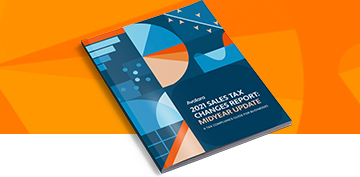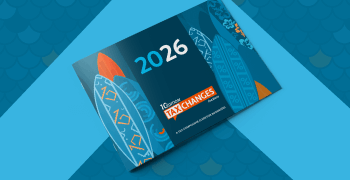
How your communications tax engine impacts shopping cart conversions
When it comes to your company's ecommerce website, there’s a lot to take into consideration. You've probably fine-tuned your product pages, optimized for search engines, and maybe even added options for customer reviews and ratings.
But have you evaluated your tax engine?
It may not be the first, fifth, or even 10th consideration on your list. However, this one area can have a surprisingly outsized impact on revenue.
How your tax engine impacts the customer experience
Research shows that more than half of online shoppers will abandon a site if it takes more than three seconds to load — and 80% of those consumers will never return.
They might add a product or service to their shopping cart. But if it’s not instantly ready for purchase when they’re ready to check out, there’s a good chance you’ll miss out on the sale. That's definitely not a small problem. As one marketing expert puts it: “A one-second delay in page response can result in a 7% reduction in conversions.” So, “if an ecommerce site is making $100,000 per day, a one-second page delay could potentially cost you $2.5 million in lost sales every year.”
Of course, page load times aren’t the only reason shopping carts are abandoned. A long or confusing checkout process, unexpected costs, and app performance issues can all cause consumers to leave your site without making a purchase.
Those issues don’t just impact traditional retailers alone. The average shopping cart abandonment rate for mobile providers is significantly higher than other ecommerce shopping carts. And while streaming, internet, VoIP, and other communications services often incur lower abandonment rates, increasing conversion remains a core objective.
In other words: An unreliable checkout experience can cause consumers to lose confidence in your products and services. And it’s crucial to see to it that your tax engine is not the weak link in your buying chain. Taxes need to be calculated and populated in your online buying experience consistently at light speed, and downtime needs to be avoided at all costs.
How your tax engine impacts cart conversions
When you invest in a tax engine, it immediately becomes a potential point of failure (or success) in your digital cart flow. Whether you’re looking to replace an existing solution or you’re just getting started with your ecommerce site, it’s important to watch for several critical factors.
First, there’s the issue of speed. When someone clicks on your “review cart” or “buy” button, it’s a clear signal of their intent to purchase. However, their final decision often hinges on having full visibility into the full cost — including itemized taxes and other regulatory fees and surcharges. If you want to ensure they’ll continue down the path toward conversion, your tax calculations need to be accurate, instant, and presented clearly in the online quote or invoice.
This goes not only for sales tax, but for any applicable communications taxes and fees as well. For companies in industries like streaming, wireless, VoIP, SMS, and even IoT, this is an especially important point to consider. There’s a vast array of state and local communications taxes, as well as federal fees, that may apply to each transaction. And they need to be calculated incredibly quickly and correctly.
To achieve the right level of velocity, it’s important to have a SaaS solution that’s engineered to accept transactions, perform the necessary calculations, and return a tax result — all in milliseconds — for even the most complex tax calculations.
Another important element to factor in is reliability: Is your cloud-based tax engine able to scale fluidly to handle peak times? Will spikes from other customers negatively impact performance? Do users complain of frequent downtimes?
When a sales rep is closing a deal with a customer, a delayed invoice here and there isn’t likely to cost you revenue. The bill can be processed at a later time, and you can continue to move through your pipeline.
Ecommerce transactions, however, occur in real time. So when your tax engine is down, your buying flow is down — which means lost revenue. In today's competitive landscape, customers frequently have options and very low thresholds for frustration. So when the buying flow fails, it increases the likelihood someone will choose not to buy from you and switch to a competitor instead.
The result is fewer sales, dissatisfied customers, and long-term damage to your brand image. Even 10 minutes of downtime can have a big impact on revenue, especially if you serve consumers across time zones.
For this reason, it’s crucial for your commerce systems, including your tax engine, to be resilient and available around the clock — with no downtime during prime buying hours. For companies selling across the U.S. or globally, that means you’ll need to be fully operational at all hours of the day.
Lastly, think about how you’ll present invoices. To prevent costly support issues, invoices need to be clear and present taxes with the appropriate level of breakdown. In addition, regulatory requirements in some jurisdictions and industries could make it necessary to itemize taxes with specific language. If your provider doesn’t give you the flexibility to do this, you could face high levels of complaints, support costs, and cancellations.
Above all, look for an established, proven solution you can count on to be fast and always on.
Moving forward with an optimized solution
When choosing a tax engine for your ecommerce site, it’s important to remember there’s more than just accuracy and compliance at stake. Today’s consumers expect the checkout process to be smooth, seamless, and near instantaneous. While you might not think of tax calculations from the perspective of your customer’s experience, the two in fact go hand in hand.
As a native SaaS tax engine born in the cloud, Avalara AvaTax for Communications is resilient and fast, with the ability to scale seamlessly. Hundreds of providers across industries, from streaming to wireless to VoIP, rely on our solutions to:
- process transactions in milliseconds
- lower the risk of outages and downtimes
- customize invoicing to ensure clarity and meet various requirements
If you haven’t already taken steps to make certain your ecommerce experience is as seamless as possible, now’s the time to start. And it’s relatively easy to do. You can start by taking a look at your site from the perspective of your customer. Click through offers and bundles, add some items to your cart, and work your way through the process.
Is the overall experience as streamlined as possible? How many times do you wait for pages to load? Were there prices and explanations that confused you? Is the experience the same at different times of day?
Answering these and other questions can often be done with minimal time and resources, and will give you a clear picture of which step you need to take next — whether that means contacting your vendor with questions or looking for a new solution.
Taking the time to ensure your tax engine is optimized for online sales now will be well worth the effort when you start to see your conversions and revenue rise.
Contact us today to find out how Avalara’s communications tax engine can work for your ecommerce solution.
New 2021 tax changes: midyear communications update
Your guide to navigating the complicated world of tax compliance and preparing for the future

Stay up to date
Sign up for our free newsletter and stay up to date with the latest tax news.














